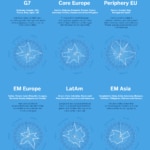Financial tensions ease across nearly every region, market, and asset class
According to BBVA Research’s latest Country Risk Quarterly Report, financial tensions have eased across all regions, markets, and asset classes with the exception of Latin America. Emerging Asia is the only region where all variables for the macroeconomic vulnerability radar analysis stand below their corresponding risk thresholds. Between 2018 and 2019 there were no significant changes to the degree of macroeconomic vulnerability across all developed economies, whereas within emerging regions, changes were concentrated in Latin America.

The report reflects easing financial tensions across all regions with the exception of some countries in Latin America. In the U.S. and Europe, this easing follows a drop in interest rates and decreased exchange rate volatility, which are partly due to reduced trade tensions and slightly better economic data. Decreased financial tensions were also observed in Emerging Europe, including Turkey. On average, early warning indicators for the major world economies do not signal a high probability of a banking crisis, with the exception of China, which continues to show high vulnerability.
According to BBVA Research's report, Emerging Asia is the only region with macroeconomic indicators that stand below their risk thresholds, although indicators of excess debt and housing prices are above their baseline, and fiscal indicators worsen slightly. As for the rest of the emerging economies, it is worth noting the increased vulnerability in Latin America stemming from less suitable foreign reserves in short term debt, although they are still far from the high risk threshold.

With respect to the developed economies, one of the weaknesses that grew worse in 2019 has been the gap between rising housing prices above levels that are consistent with the long-term trend, thus this indicator hovers at the high risk threshold, according to data cited in the report. This is also true for both the core European countries and those countries that comprise the G7. This same risk is also at play in the major Latin American economies.
Within European peripheral countries, public leveraging represents a high risk; whereas in Central Europe, corporate debt is reaching elevated risk thresholds. As for the G7 countries, weak economic growth and high levels of public debt compared to the developed economies overall is a concern.
The level of external debt is another vulnerability that could pose a risk to Peripheral Europe, Emerging Europe, and Latin America.